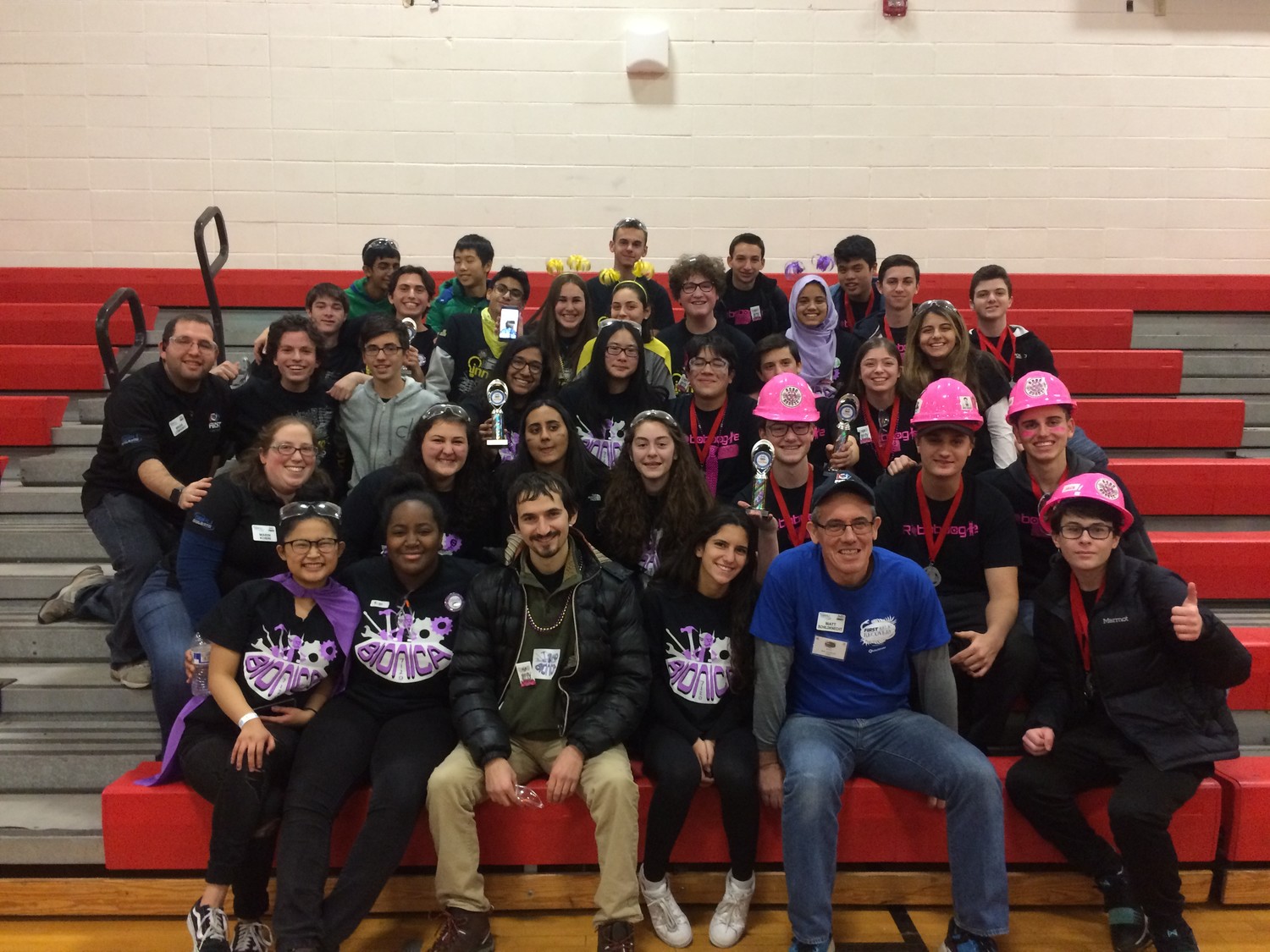Hewlett High School robotics advances to the regionals
Three teams win 10 awards
From a classroom in Hewlett High School to basements across the Hewlett and Woodmere communities, high school students on the three robotics teams — Bionica, Innovo and Roboboogie — continue their tinkering as they prepare for the Long Island First Tech Challenge regionals at Smithtown High West on Feb. 11.
Hewlett’s trio of teams qualified for the regionals after a dominating display of their technical talents on Jan. 14 at Center Moriches High School. This is the first time all three teams qualified at the same tournament.
“The kids are psyched. They are elated and quite relieved,” said robotics team coach Janine Torresson. “The competitions are getting more intense. The kids were holding their breath. They thought what they brought wasn’t enough, but at the end it was.”
Bionica, led by co-captains Bharvi Chavre and Jada Letts, captured the first-place Connect Award at the Jan. 14 tournament. Their season got off to a strong start as the all-girls team won the first-place Think Award for its well-documented engineering process and notebook, and took the second-place Connect Award at the Jan. 7 competition at Lynbrook High School, the first tournament of the robotics season.
“All the girls on the team are taught to reach out to the community to give back and help inspire other girls to get involved in STEM,” said Chavre, a junior who began her robotics career as an eighth-grader.
STEM stands for science, technology, engineering and math. “I have honestly learned so much in my two and a half years of building robots. One of the most important things is this amazing family I can go to whenever. We have dinners, play games. I am so grateful.”
Innovo — its name is the Latin word for innovation — took home the first-place Design Award, the second-place Think Award for engineering process and the third-place Connect, Inspire and Motivate awards at the Jan. 14 tournament.
“Nothing works on the first try is an important lesson of failure,” said senior Nathaniel Eisenberg, who captains the team. “At a scrimmage in December, the robot was ready to go, but when we got there, nothing worked. It was one fail after another.”
Eisenberg said the team went back to the literal chalkboard. “Not just the chalkboard — white board, smart board, we use everything,” he said. The students work at school and also at their homes.
Roboboogie, led by senior Brian Katz, won the overall competition with the first-place Inspire Award, second-place Innovate Award and third-place Design Award, and was selected for the Finalist Alliance and took part in the final matches on Jan. 14. At the season-opening competition on Jan. 7, the team captured the first-place Connect Award for its connections to the engineering and business communities.
Should any of the Hewlett teams succeed at the regionals — only three teams out of 25 are considered winners — they would advance to the super-regionals in Scranton, Pa., in March.
“Right now it’s one step at a time. We are at where it’s really difficult to succeed,” Katz said. “We’re hoping to perform well at the regionals. If we go on to win, we’ll make a few changes to compete. The super-regionals are a whole different story.”
Last year there were three qualifying competitions and eight teams advanced, Torresson said. This year there are five competitions and five teams move on. Besides having to ensure that their robots perform well, the teams must function as small businesses and link up with real engineers.
“They have to learn the software and the programming to solve the puzzle and the mechanics to achieve that change,” Torresson added. The teams also present their projects to the judges for five minutes at the competitions, and the judges ask questions for another five minutes.
The robotics teams lost 25 four-year students after graduation last year, Torresson said, and replenishing them wasn’t easy. The club includes up to 60 students, and there are upward of 20 on each team. To qualify for a team, students must show what they know through tests.
Students such as senior Luigi Conti and sophomore Michael Green, both new to the school’s robotics program, joined the Roboboogie team. Torresson said the pair are computer programmers and know Java — the computer programming language.
“The kids are quite genuine, and they love it,” Torresson said. “They are very dedicated, and for six hours every day from September to March, we’re working on their business plans and robots, and upping our game.”
At Arts Below Sunrise, the one-day festival held by the Hewlett and Woodmere communities that includes a science component, David Murphy and Edward Cerverizzo, college students with computer-driven interests, approached the students.
Murphy, a graduate of SUNY Geneseo who is working on a second bachelor’s in computer science at Molloy College, and Cerverizzo, a graduate of SUNY Cortland pursuing a master’s degree at Queens College, spent many hours helping the robotics teams, Torresson said.
“David and Ed helped the two new recruits” — Luigi Conti and Michael Green, Katz said. “Last year we had a single programmer. The two college students helped direct them.”
No matter how competitive the tournaments are, the students are also judged on how well they get along with their opponents. The lesson is that people don’t succeed in a vacuum. “It’s called gracious professionalism,” Chavre said. You compete, but you also help out in times when other teams need wires or batteries.”






